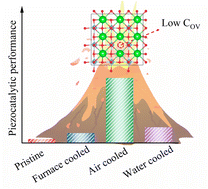Significantly enhanced piezocatalytic activity of BaTiO3 by regulating the quenching process†
Abstract
Quenching has been demonstrated to have great effects on the electrical properties of piezoelectric materials. Conceivably, it inevitably influences the piezocatalytic performance, however, no research on this has been reported. Herein, we studied the influence of quenching on piezocatalytic performance and elucidated the underlying regulatory mechanism. BaTiO3 (BTO) particles were calcined and quenched using different modes, including furnace cooling, air cooling, and water cooling. The results revealed that accelerating the cooling rate and reducing the concentration of oxygen vacancies (COV) enhanced the piezoelectric and ferroelectric performances. Under the synergetic effect of a low COV and high cooling rate, the air-cooled BTO exhibited significantly enhanced piezocatalytic degradation activity, with a large degradation rate constant k of 0.077 min−1, which is almost 15.40, 6.16, and 3.35 times that of the pristine, furnace-cooled, and water-cooled ones, respectively. Additionally, the air-cooled BTO displayed an optimal piezocatalytic H2 evolution rate of 1.43 mmol h−1 g−1 with methanol as the sacrificial agent. The piezoelectricity, ferroelectricity, carrier characteristics, and adsorption ability of the samples were systematically investigated to unveil the underlying enhancement mechanism. This straightforward and simple approach provides an alternative perspective on the design and fabrication of high-performance piezocatalysts.

- This article is part of the themed collection: #MyFirstJMCA


 Please wait while we load your content...
Please wait while we load your content...